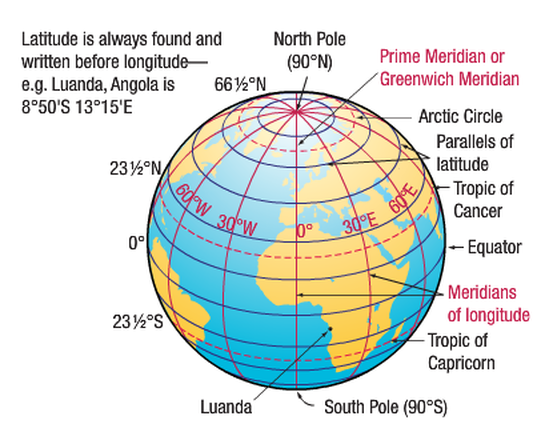Common GK Questions for SSC Exams

Which of the following parallels of latitude represent the Tropic of Capricorn?
(A) 23½° in the Northern Hemisphere
(B) 66½° in the Southern Hemisphere
(C) 23½° in the Southern Hemisphere
(D) 66½° in the Northern Hemisphere
Correct Answer : C
Explanation :
 1. The 23.5 degree parallel of latitude in the Southern Hemisphere represents the Tropic of Capricorn.
1. The 23.5 degree parallel of latitude in the Southern Hemisphere represents the Tropic of Capricorn.
2. The Tropic of Capricorn (or southern tropic) is the circle of latitude in which the perihelion point occurs at the December (or southern) solstice.
3. Thus it is the southernmost latitude where the Sun can be seen directly overhead.
4. It reaches 90 degrees below the horizon at solar midnight on the June solstice.
5. The Tropic of Capricorn is one of the five major latitude lines of the Earth. The other four are latitude lines.
- Equator (0 degrees latitude)
- Tropic of Cancer (23.5 degrees north latitude)
- North Pole Circle (66.5 degrees north latitude)
- South Pole Circle (66.5 degrees south latitude)
Through which of the following countries does the Tropic of Capricorn pass?
(A) Australia
(B) Brazil
(C) Chile
(D) All options are correct
Correct Answer : D
Explanation :
1. A total of ten countries are located on the Tropic of Capricorn. They are spread over three continents. Of the ten countries located on the Tropic of Capricorn, five are African countries.
2. They are Namibia, Botswana, South Africa, Mozambique and Madagascar. Argentina, Brazil, Chile and Paraguay are South American countries located on the Tropic of Capricorn.
3. Apart from five African countries and four South American countries, Australia is also located on the Tropic of Capricorn.
Which is the competent body to determine the conditions for obtaining citizenship?
(A) Election Commission
(B) President
(C) Parliament
(D) Parliament and Legislative Assemblies
Correct Answer : C
Explanation :
The Parliament is the competent body to prescribe conditions for acquisition of citizenship. The Parliament of India can prescribe conditions as for acquiring Indian citizenship.
Under which scheme in the year 1942 it was accepted that an elected Constituent Assembly would be formed in India, which would form a post-war constitution?
(A) Round Table Conference
(B) Cripps Scheme
(C) Constituent Assembly
(D) None of these
Correct Answer : B
Explanation :
Cripps MissionIn March 1942, a mission headed by Stafford Cripps was sent to India with constitutional proposals to seek Indian support for the World War II.
Which rule has been provided in Article 17 of the Indian Constitution?
(A) Equality before law
(B) Equality of opportunity in matters of government employment
(C) Abolition of titles
(D) Eradication of untouchability
Correct Answer : D
Explanation :
Article 17 of the Indian Constitution states that “Untouchability” is abolished and its practice in any form is forbidden. The enforcement of any disability arising out of “Untouchability” shall be an offence punishable in accordance with the law.
Which of the following saints used to work as a cobbler?
(A) Tulsidas
(B) Surdas
(C) Raidas
(D) Malukdas
Correct Answer : C
Explanation :
Guru Ravidas is known as the cobbler saint. He was a great philosopher, saint, and social reformer of the 15th century.
Which of the following is a characteristic of the Dravidian style of temple architecture?
(A) Pinnacle
(B) Gopura
(C) Aircraft
(D) Pavilion
Correct Answer : C
Explanation :
The front wall has an entrance gateway in its centre, which is known as a Gopuram. The shape of the main temple tower known as vimana in Tamil Nadu is like a stepped pyramid that rises up geometrically rather than the curving shikhara of North India.
With whom did the Grand Trunk Road built by Sher Shah connect Punjab?
(A) Agra
(B) East Bengal
(C) Lahore
(D) Multan
Correct Answer : A
Explanation :
Sher Shah Suri is named as the builder of Grand Trunk Road, the east-west road, which connects Bengal to Punjab.
Who propounded the path 'Ashtangik Marg' for the end of human sorrows?
(A) Mahavira
(B) Gautam Buddha
(C) Adi Shankaracharya
(D) Kabir
Correct Answer : B
Explanation :
The Buddha explained that without attachment, aversion and attachment (raga, dvesha, moha), lust does not cause bondage. The fourth noble truth about suffering is that there is a path (marga) to reach a state free from suffering - one that the Buddha followed and that others can follow. He called it the Eightfold Path to Liberation.



